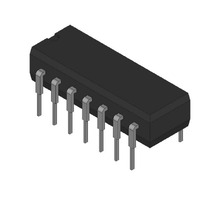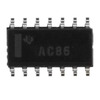Manufacturer Part Number
SN74LS32N
Manufacturer
Texas Instruments
Introduction
The SN74LS32N is a quad 2-input OR gate logic IC from Texas Instruments, part of the 74LS family designed for digital computing and signal processing.
Product Features and Performance
Quad 2-input OR gate functionality
Supports a voltage supply range of 4.75V ~ 5.25V
Capable of delivering output current of 400µA (High) and 8mA (Low)
Low input logic level at 0.8V and high input logic level at 2V
Maximum propagation delay of 22ns at 5V and 15pF load
Operates within a temperature range of 0°C to 70°C
Through hole mounting type for easy PCB integration
Product Advantages
Ensures reliable logical operations with minimal delay
Compatible with a wide range of supply voltages
High drive capability with low power dissipation
Easy to implement in various digital circuits due to standard DIP packaging
Key Technical Parameters
Supply Voltage: 4.75V ~ 5.25V
Output Current High, Low: 400µA, 8mA
Input Logic Level Low: 0.8V
Input Logic Level High: 2V
Propagation Delay: 22ns @ 5V, 15pF
Operating Temperature: 0°C ~ 70°C
Quality and Safety Features
Manufactured by Texas Instruments, a leader in semiconductor design
Rigorous quality control and testing for reliable operation
Complies with standard safety and operational guidelines
Compatibility
Compatible with other LS (Low Power Schottky) series components
Through hole mounting supports use with standard PCBs
Application Areas
Digital logic circuits
Signal processing
Computing devices
Industrial controls
Product Lifecycle
Product Status: Active
Continuously manufactured and supported, not nearing discontinuation
Replacements or upgrades readily available within the 74LS series
Several Key Reasons to Choose This Product
High-reliability and low propagation delay improve signal processing speed
Wide voltage supply range offers flexibility in circuit design
High output drive capability supports multiple loads
Manufactured by Texas Instruments, ensuring quality and durability
Versatile application potential, from computing to industrial controls





 SN74LS348NTexas InstrumentsIC PRIORITY ENCOD 1 X 8:3 16DIP
SN74LS348NTexas InstrumentsIC PRIORITY ENCOD 1 X 8:3 16DIP SN74LS33DTexas Instruments
SN74LS33DTexas Instruments SN74LS33NSRTexas InstrumentsIC GATE NOR OP COL 4CH 2IN 14SOP
SN74LS33NSRTexas InstrumentsIC GATE NOR OP COL 4CH 2IN 14SOP SN74LS32DBRTexas InstrumentsIC GATE OR 4CH 2-INP 14SSOP
SN74LS32DBRTexas InstrumentsIC GATE OR 4CH 2-INP 14SSOP SN74LS323NTexas InstrumentsSHIFT REGISTER, 8-BIT, TTL
SN74LS323NTexas InstrumentsSHIFT REGISTER, 8-BIT, TTL